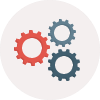Business analysts at RS collaborate closely with customer representatives, eliciting and validating requirements through interviews, user interface design walkthroughs, or prototype evaluations. The requirements development process within our company embraces the following stages:

Scope Definition
- Understanding the business vision, goals and objectives of the new or replaced solution
- Defining the context for the project undertaking

Analysis
- Analyzing the elicited solution ideas, business, user, functionality and data requirements
- Analyzing constraints, business rules, and solution quality attributes
- Prototys of the proposed solutions

Validation
- Prototyping requirements
- Testing requirements
- Negotiating, validating and verifying requirements with all stakeholders

Elicitation
- Identifying requirements stakeholders
- Eliciting requirements through interviews, workshops, focus groups, observations, document analysis, etc

Documentation
- Structuring and categorizing the requirements
- Ensuring every individual business, user, functional, and nonfunctional requirement is complete, correct, feasible, concise, prioritized, unambiguous and verifiable

Management
- Managing requirements version control, change control, requirements status tracking and tracing
- Enabling requirements reuse and risk management
Deliverables
Requirements Specifications
The complete, concise, consistent and modifiable documentation (vision and scope document, SRS, use cases, etc.) delivered by Iflexion provide our Customers with a reliable basis for subsequent project planning, design, and coding.
The delivered specifications describe as completely as necessary the system’s required functionality and behaviors under various conditions, desired system qualities such as performance, usability, and security, as well as design and implementation constraints.
Technical Design
Specific and detailed business architecture models, including business process workflows, state diagrams, and external system integration mapping in modifiable format, delivered by Rendered Source providing you a clear understanding.
Data architecture models provide a field-level specificity in combination of application architecture models (class diagrams, API's) identifying the technical implementation details necessary for developers to build the system, and QA to test the system.
UI/UX Mockup
A visual representation of the system showing the screens as they will be when the system is completed. Supplemental artifacts include screen designs, personas, user flow, experience maps, use cases, and storyboards.
We determine the necessary design artifacts, appropriate for the project size/scope, with you.
Working Prototype/Proof-of-concept
Experiencing the flow of the system requires the ability to get your hands on it. We provide clients clickable prototypes, which simulate how the user experience would feel.
Proof of concept systems developed by Rendered Source include source code and design assets necessary to run the project in it's natural environment.
Precision and flexibility in harmony when working with Rendered Source
FLEXIBLE
ENGAGEMENT
Adapting is our strong suit. We offer multiple engagement models that make working with Rendered Source feel like we're already a part of your team.
ACCURATE
IMPLEMENTATION
We provide high quality designs implemented with pixel perfect precision to accomplish your most important business objectives.
AGILE
APPROACH
We incrementally deliver the highest priority features until the overall project meets or exceeds your expectations.
SCOPE CREEP
MANAGEMENT
The only thing constant is change, and Rendered Source gracefully manages this through iteration management and refactoring.